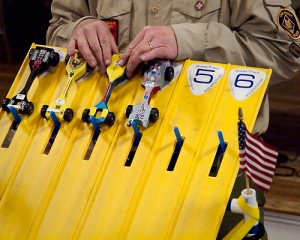Pinewood Derby® Tips For Maximum Speed
It’s Pinewood Derby season and we want to share some tips that will help you and your Scouts have a great time at your pack’s Pinewood Derby.
In part 1 of this 4 part series, we’re going to offer some tips to consider when trying to build the fastest car.
Derby cars have been racing down tracks for over 57 years now and while car designs and the tools used to make them have come a long way in that time, the principles of having the fastest car remain the same.
The difference between having a Pinewood Derby winner and a dud usually comes down to 3 factors we’ll call W.A.W. or “wheels,” “axles,” and “weight.”
First, when buying a kit, inspect the wheels to make sure they are all smooth and perfectly round. If any of your wheels appear to have a minor defect in smoothness or shape, sand them down with a 400, 600, or 1000-grit sandpaper. Lightly sanding the hub of the wheels (where the wheel comes in contact with the axle) to create a smooth, uniform surface will reduce friction on the axle and increase speed. Also, check with your local Pinewood Derby race officials to see what wheel lubricants are allowed. Always follow manufacturer’s guidelines when using lubricants that contain potentially harmful chemicals.
Once the wheels are ready to roll, you have to attach them to your car with an axle. According to DK Publishing’s Pinewood Derby Speed Secrets there should be 1/32″ of space between the wheels and the car body. Give each wheel a spin to see that it is balanced on the axle and make adjustments until all wheels spin without bobbling or shifting forward or back. Also, a wheel should never move in or out on its axle while the car is rolling. A well-fitted wheel can spin up to 20 seconds before stopping. Checking that wheels are all aligned and making even contact with a flat surface will ensure your car will go straight down the track without losing speed.
The final factor to consider when building your car for speed is weight. If you construct your car’s body in such a way that weight can be easily added or removed, you’ll be able to make your car the heaviest allowable weight on race day. Gravity plays a big part in the Pinewood Derby. The heavier the car, the faster it will go down the track. Putty, fishing weights, modeling clay, and small pieces of hardware can be added or removed at the last minute to gain that perfect race day weight. Avoid using lead as a weighing device, as handling it is very dangerous. Pinewood Derby Speed Secrets contains plenty more advice on proper weight placement for maximum finishing speed.
Building and racing a car at the Pinewood Derby has been a rewarding experience for Scouts and their parents for years. If a little care and thought goes into W.A.W. before the race, you may just find yourself a Pinewood Derby champion when it is all said and done. Check back next week for part 2 of this series, where we will cover design ideas for creating a great-looking car.
Are you a Pinewood Derby champ? Do you have any speed secrets you’d be willing to share? If so, leave us a comment!
